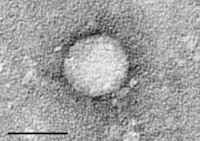
The Ratio of Eicosapentaenoic Acid (EPA) to Arachidonic Acid may be a Residual Risk Marker in Stable Coronary Artery Disease Patients Receiving Treatment with Statin Following EPA Therapy
Sign Up to like & getrecommendations! Published in 2017 at "American Journal of Cardiovascular Drugs"
DOI: 10.1007/s40256-017-0238-z
Abstract: BackgroundWe investigated the relationship between the eicosapentaenoic acid (EPA)/arachidonic acid (AA) ratio and non-high-density lipoprotein cholesterol (non-HDL-C) level, a major residual risk of coronary artery disease (CAD), in statin-treated CAD patients following EPA therapy.MethodsWe conducted… read more here.
Keywords: non hdl; ratio; epa; residual risk ... See more keywords

Residual risk for clinically significant copy number variants in low-risk pregnancies, following exclusion of NIPS-detectable findings.
Sign Up to like & getrecommendations! Published in 2021 at "American journal of obstetrics and gynecology"
DOI: 10.1016/j.ajog.2021.11.016
Abstract: BACKGROUND Chromosomal microarray analysis (CMA) detects clinically significant copy number variants (CNVs) in about 1% of low-risk pregnancies. As the constantly growing wide use of non-invasive prenatal screening (NIPS) facilitates the detection of chromosomal aberrations,… read more here.
Keywords: risk; risk clinically; clinically significant; nips detectable ... See more keywords

Targeting PCSK9 to reduce residual risk in ACS
Sign Up to like & getrecommendations! Published in 2018 at "Nature Reviews Cardiology"
DOI: 10.1038/s41569-018-0125-6
Abstract: Patients who have had an acute coronary syndrome (ACS) are at high risk of recurrent cardiovascular events, particularly patients whose LDLcholesterol (LDLC) levels remain elevated despite receiving highintensity statin therapy. The ODYSSEY OUTCOMES trial now… read more here.
Keywords: risk; pcsk9 reduce; targeting pcsk9; pcsk9 ... See more keywords

Recently Acquired Blood-borne Virus Infections in Australian Deceased Organ Donors: Estimation of the Residual Risk of Unexpected Transmission
Sign Up to like & getrecommendations! Published in 2023 at "Transplantation Direct"
DOI: 10.1097/txd.0000000000001447
Abstract: Background: Unexpected donor-derived infections of hepatitis B virus (HBV), hepatitis C virus (HCV), and HIV are rare but important potential complications of deceased organ transplantation. The prevalence of recently acquired (yield) infections has not been… read more here.
Keywords: recently acquired; deceased organ; risk; yield ... See more keywords

Residual risk estimates of transfusion transmissible hepatitis B, hepatitis C and human immunodeficiency virus using nucleic acid testing yield/window period model in an Indian setting
Sign Up to like & getrecommendations! Published in 2022 at "Transfusion Medicine"
DOI: 10.1111/tme.12923
Abstract: Estimation of residual risk (RR) is necessary to understand status of blood safety with current testing strategies and need to improve it further. These estimates from India are lacking till date. Present study was aimed… read more here.
Keywords: estimates transfusion; risk estimates; hepatitis; residual risk ... See more keywords

Do high‐risk behavior deferrals work? How to make it better?
Sign Up to like & getrecommendations! Published in 2019 at "Transfusion"
DOI: 10.1111/trf.15409
Abstract: H igh-risk behavior deferrals are one of several mechanisms employed by blood centers to reduce transfusion-transmitted infection (TTI) risk. Predonation donor screening includes a donor history questionnaire (DHQ) interview before eligible donors undergo TTI screening… read more here.
Keywords: risk; high risk; donor; risk behavior ... See more keywords

Residual recurrence risk of ischaemic cerebrovascular events: concept, classification and implications
Sign Up to like & getrecommendations! Published in 2021 at "Stroke and Vascular Neurology"
DOI: 10.1136/svn-2021-000885
Abstract: © Author(s) (or their employer(s)) 2021. Reuse permitted under CC BYNC. No commercial reuse. See rights and permissions. Published by BMJ. INTRODUCTION Patients with stroke still have substantial residual risk of stroke recurrence in spite… read more here.
Keywords: risk; recurrence risk; recurrence; stroke recurrence ... See more keywords

Validation of a combined residual risk score for healthy unaffected women presenting to breast cancer (BC) screening centers.
Sign Up to like & getrecommendations! Published in 2018 at "Journal of Clinical Oncology"
DOI: 10.1200/jco.2018.36.15_suppl.1507
Abstract: 1507Background: Recent studies have identified single-nucleotide polymorphisms (SNPs) that individually confer modest risk but together explain genetic BC predisposition in many women testing negative for monogenic mutations. We have previously developed and validated an 86-SNP… read more here.
Keywords: risk; screening centers; combined residual; risk score ... See more keywords

Prevalence, incidence and residual risk of transfusion-transmitted HBV infection before and after the implementation of HBV-NAT in northern Brazil
Sign Up to like & getrecommendations! Published in 2018 at "PLoS ONE"
DOI: 10.1371/journal.pone.0208414
Abstract: Background Nucleic acid testing (NAT) for virus detection during blood screening has helped to prevent transfusion-transmitted infections worldwide. In northern Brazil, NAT was implemented in 2012 for HIV and HCV and more recently, in January… read more here.
Keywords: hbv nat; implementation; hbv; prevalence ... See more keywords

Cardiac Alarmins as Residual Risk Markers of Atherosclerosis under Hypolipidemic Therapy
Sign Up to like & getrecommendations! Published in 2022 at "International Journal of Molecular Sciences"
DOI: 10.3390/ijms231911174
Abstract: Increased levels of low-density lipoproteins are the main risk factor in the initiation and progression of atherosclerosis. Although statin treatment can effectively lower these levels, there is still a residual risk of cardiovascular events. We… read more here.
Keywords: group; risk; cardiac alarmins; residual risk ... See more keywords

Residual risk of infection with blood‐borne viruses in potential organ donors at increased risk of infection: systematic review and meta‐analysis
Sign Up to like & getrecommendations! Published in 2019 at "Medical Journal of Australia"
DOI: 10.5694/mja2.50315
Abstract: To estimate the prevalence and incidence of human immunodeficiency virus (HIV), hepatitis C virus (HCV), and hepatitis B virus (HBV) among people at increased risk of infection in Australia; to estimate the residual risk of… read more here.
Keywords: risk infection; risk; increased risk; organ donors ... See more keywords